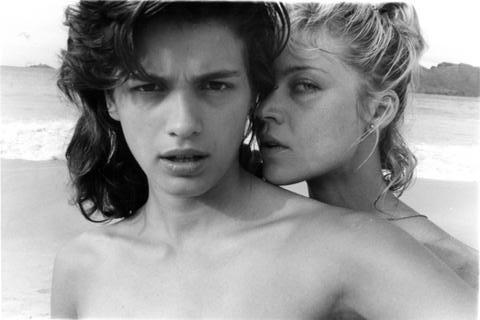Gia Carangi by Hanna Hanra
Illustration by Fernando Monroy
Me and Matt were in HMV on Oxford Street – we were in one of those places in life when you get thrown the idle bone of time. We had nothing else to do but cruise around the store, laughing at DVDs, a medium that even back then, seemed defunct. It was, as always 3 for £10, I can’t remember the first and second choices but the third was ‘Gia’.
Gia Carangi was the first supermodel, but hers is a tragic story. Born in Philadelphia in 1960, her Italian / Irish parents were often violent and unstable; her mum walked out when Gia was just 11. At high school, Gia befriended a group of kids who were obsessed with David Bowie. She too was drawn to him, with his weird glam style and his waft of bisexuality that bent the hard lines that defined gender. How could you not be? Like many lesbians, Gia hung out at gay clubs, slightly in denial and unwilling to accept her own queerness, she “did not want to take up the accepted lesbian style”. The film was made in the late 90s and stars Angelina Jolie as Gia. Discovered by a powerful casting agent, Gia quickly becomes ‘the face of the moment’ but after her agent’s sudden death, Gia’s loneliness drives her to start experimenting with drugs. One day on a shoot, she meets Linda, a make up artist. They have a passionate affair after they both pose nude against a chain fence in a car park. (This is real by the way). Gia becomes more and more addicted to drugs – eventually Linda gives her an ultimatum: Gia chooses drugs. Things worsen, she tries to reconcile with her parents but this drives her to trying heroin. She contracts HIV and sadly, in 1986, she died of AIDS.
Gia and Linda
Slitting open the plastic wrap and cracking open the DVD in my living room, me and Matt cackled. With it’s brown sofa and the hole in the ceiling – we’d say it was crying tears of heartbreak every time it rained – it was far from the glamour of 80’s fashion shoots that Gia took place in. Like, really far. But something about her struck a chord.
She hadn’t wanted to be seen as ‘a lesbian’. The feeling of wearing one’s sexual politics as part of one’s identity has always jarred with me. Why can’t I wear what I want to wear and sleep with who I want to sleep with? I appreciate that some people need or want to feel part of a tribe, but for me… that felt out of sync. I was at an age when I had so many questions about myself, and each scene felt like it got a little closer to some being answered. What did being a lesbian look like? Well. It could look like many things, Angelina Jolie in a ballgown or a leather jacket. Cool.
Matt was one of the few gay male friends I had who hadn’t chided me about being gay. He never asked about it or told me ‘I think you’re gay.’ It was wearing a nice perfume – noted but undiscussed. I think it was because he had had a hard time with his gayness, growing up in a religious family who rejected him because of it. Girls had always been my downfall, but I kept those feelings tucked away and hid them with a fake protestation of wanting a boyfriend. Matt knew where those feelings lay inside of me and rather try and unlock the box where they were kept, he showed me the final number of the combination lock to open it up.
Stretched out on the sofa, we watched the film. Although the story is deeply sad, we couldn’t help but laugh at the way the more intimate moments had been handled. The camera goes soft, and a light jazz plays over the footage, while Gia and Linda go to town in the sack. Tears rolled down our cheeks as we made sexy light jazz noises to each other, laughing and crying at the same time.
Years have passed since that day – more than ten, for sure. Time has changed and it’s perhaps easier now to be openly queer than ever. I’m happy to wear a dress or a leather jacket or neither or both at the same time. My friend Matt is no longer with us. But I am happy to say I still carry his jazzy sax impression with me wherever I go.
Fernando Monroy is a Mexican illustrator currently studying in México city. His work references pop culture, reflecting the work of photographers, designers and fashion. Out Magazine named him one of twenty young queer artists to watch.



